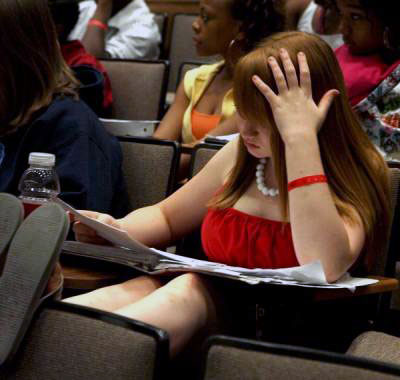All Nonfiction
- Bullying
- Books
- Academic
- Author Interviews
- Celebrity interviews
- College Articles
- College Essays
- Educator of the Year
- Heroes
- Interviews
- Memoir
- Personal Experience
- Sports
- Travel & Culture
All Opinions
- Bullying
- Current Events / Politics
- Discrimination
- Drugs / Alcohol / Smoking
- Entertainment / Celebrities
- Environment
- Love / Relationships
- Movies / Music / TV
- Pop Culture / Trends
- School / College
- Social Issues / Civics
- Spirituality / Religion
- Sports / Hobbies
All Hot Topics
- Bullying
- Community Service
- Environment
- Health
- Letters to the Editor
- Pride & Prejudice
- What Matters
- Back
Summer Guide
- Program Links
- Program Reviews
- Back
College Guide
- College Links
- College Reviews
- College Essays
- College Articles
- Back
Meditation in Schools MAG
The schedule of the American teenager drowns us. According to the American Psychological Association, young adults are now the most stressed age group. This stress not only harasses our days, it also intrudes upon the sanctuary of our slumber; students often report sleepless nights. The problem is not what our education system is doing, but what it is not doing. High schools do not teach students how to revive their overactive minds, bodies, and spirits. This can only be done through the ancient practice of meditation. Meditation should be required in high schools because it reduces stress levels, leads to restful sleep, and improves brain functions that help students achieve academic success.
Envision this: You rise from bed before the sun and hastily rush off to school, where you struggle sleepily through classes and coursework. A quick moment is allowed for socializing, and then you drag your body off to the extracurricular activities that promise a rounded transcript. Homework, homework, homework. Then, suddenly, you are under the sheets, attempting to sleep. Sound familiar? This is the typical day of an American teenager, and the sprint through the hours reaps stress. As most students’ anxiety comes from academics, it is the responsibility of high schools to offer some relief.
Meditation is the best tool for students to relieve stress. According to the Chopra Center, “Meditation mitigates the effects of the fight-or-flight response, decreasing the production of stress hormones, such as cortisol and adrenaline.” High schools should provide time in the day for students to relax the body and the mind, to break the poisonous monotony of a strained schedule. For meditation to be effective, it needs to last just 15 minutes a day. The process is simple: sit and clear your mind of negative thoughts.
Lack of sleep is another unhealthy aspect of teen life that can be eased with meditation. According to the University of Texas, “Teens who don’t get enough sleep are four times as likely as well-rested teens to develop major depressive disorder.” Meditation works by sweeping out toxic thoughts and training the brain to let go of worries. When students learn to control troubled thinking, they will be able to snooze comfortably. This creates a more nourished mind that is ready to tackle tests and busy days.
Finally, meditation is a wonderful way to improve the high school experience for students overall. Various stressors linked with social life, such as peer pressure and the desire for acceptance, become more tolerable through meditation. The Chopra Center says that meditation offers a “refuge from painful, fearful, or angry thoughts” and provides a “greater self-understanding.” This is particularly useful for students who are beginning the college search process. Increased intuitive powers, improved ability to concentrate, and expanded consciousness are just a few of the benefits of meditation. People who meditate also have lower blood pressure.
It is surprising that meditation is not already a mandatory part of school. Schools are the masters of implanting good habits in young people; it is time that they encourage a custom that will replenish teenagers and help them handle the challenges of a rigorous school day.

Similar Articles
JOIN THE DISCUSSION
This article has 0 comments.
